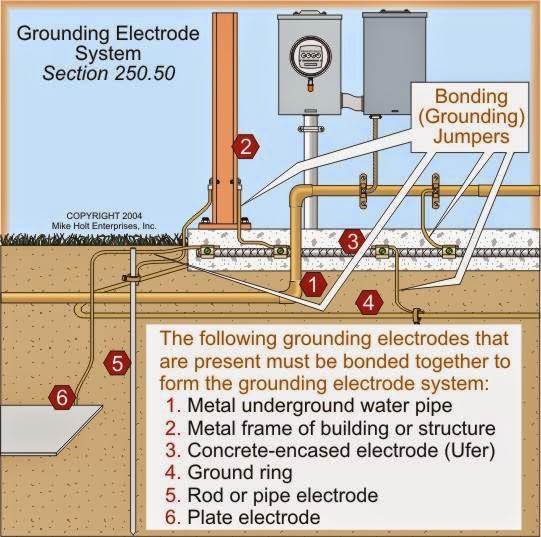Understanding The Grounding Electrode System: A Comprehensive Guide
The grounding electrode system is a fundamental component of electrical safety and efficiency. It serves as the crucial link between electrical systems and the earth, providing a path for fault currents to safely dissipate. Understanding how this system works and its significance can be vital for homeowners, electricians, and engineers alike. A properly installed grounding electrode system not only protects equipment from damage but also enhances the safety of individuals by minimizing the risk of electrical shocks.
In an era where our reliance on electrical systems continues to grow, the importance of a reliable grounding electrode system cannot be overstated. This system is designed to mitigate the risks associated with lightning strikes, power surges, and other electrical anomalies that could lead to catastrophic failures. By ensuring that electrical currents have a safe path to the ground, we can protect both our devices and our lives.
As we delve deeper into the intricacies of the grounding electrode system, we will explore its components, installation processes, and maintenance requirements. Each element plays a crucial role in ensuring that the system functions effectively and meets the standards set by electrical codes. Understanding these details will empower individuals to recognize the importance of grounding and how to implement it effectively in various settings.
What is a Grounding Electrode System?
The grounding electrode system consists of various components that work together to connect electrical systems to the earth. Key elements include grounding rods, plates, and conductors, all designed to create a low-resistance path for fault currents. This system is essential for protecting electrical installations and ensuring safety.
Why is a Grounding Electrode System Important?
Electrical safety is paramount in any installation, and grounding electrode systems play a critical role in achieving this. Here are some key reasons that underline their importance:
- Protection against electrical shocks.
- Minimization of equipment damage during power surges.
- Improved safety during lightning strikes.
- Compliance with electrical codes and regulations.
How Does a Grounding Electrode System Work?
The grounding electrode system functions by providing a physical connection to the earth, allowing electrical currents to flow safely away from sensitive equipment and individuals. When a fault occurs, such as a short circuit, the excess current is directed into the grounding system, thus preventing damage and maintaining safety.
What Are the Components of a Grounding Electrode System?
Several key components make up an effective grounding electrode system:
- Grounding Rods: Typically made of copper or galvanized steel, these rods are driven deep into the ground.
- Grounding Plates: Flat metal plates buried underground to provide additional surface area for grounding.
- Grounding Conductors: Wires that connect the grounding rods or plates to the electrical system.
- Bonding Jumpers: Wires that connect different grounding systems to ensure equal potential.
What Are the Best Practices for Installing a Grounding Electrode System?
When installing a grounding electrode system, following best practices is essential to ensure its effectiveness and reliability. Here are some key considerations:
- Follow local electrical codes and regulations.
- Choose appropriate materials that suit the environment.
- Ensure proper depth and spacing for grounding rods.
- Conduct regular maintenance checks to ensure functionality.
How Can You Maintain Your Grounding Electrode System?
Maintenance of the grounding electrode system is crucial for its longevity and effectiveness. Here are some maintenance tips:
- Inspect connections regularly for signs of corrosion or wear.
- Test the resistance of the grounding system periodically.
- Ensure that no vegetation or debris obstructs grounding rods.
What Are Common Misconceptions About Grounding Electrode Systems?
Despite their importance, several misconceptions surround grounding electrode systems. Here are a few:
- Misconception 1: Grounding systems are only necessary for commercial buildings.
- Misconception 2: Any metal object can serve as a grounding electrode.
- Misconception 3: Once installed, grounding systems never need maintenance.
Conclusion: The Crucial Role of Grounding Electrode Systems
In conclusion, the grounding electrode system is an essential element of electrical safety. By understanding its components, functions, and maintenance requirements, individuals can ensure that their electrical systems are not only effective but also safe. As we continue to rely on electricity in our everyday lives, prioritizing grounding safety will protect our devices and, more importantly, our lives.
Article Recommendations
- Great British Bake Off Shop
- Birthday January 16 Astrologyl
- Robert De Niro Taxi Driver
- Primetime Emmy Award For Outstanding Reality Program
- How Old Was Michael J Fox Back To The Future
- Larenz Tate Diet
- Where Is The Swans Streaming
- Black Donals Trump
- Stevie Nicks Bio
- Going Gluten Free Changed My Life



